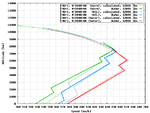But there's also 'reverse national pride' sometimes, wanting to take certain other countries down a notch and so not looking into facts carefully enough when that's what they appear to do. I'm not saying it applies to you, but it does apply IMO to cases where Soviet accounts of Korea are presented in a misleading way.Hi Catch22,
Clay Allison: Take a look at how many 10 plus kill aces the USA and the Soviets had in Korea. Also check out who was the top scorer in that conflict, and consider that the high scoring US pilots did so primarily against North Korean pilots while the Soviets racked up their scores against arguably the best trained pilots in the world.
I admire national pride, but it needs to be backed up with more tangible arguments than opinion.
The big picture in Korea is not that most US victories were against the North Koreans. Over half the officially admitted MiG-15 air combat losses were Soviet AF (319 per one good Russian source, other sources vary slightly). Most of the rest were PLAAF (224 is their official air combat loss total). The North Koreans themselves probably only lost a few dozen MiG-15's in air combat. F-86's claimed almost 800 MiG's (other fighter types claimed few, B-29's were credited 27 but most of those can be seen to have been overclaims) v that probably ~600 actual MiG-15 air combat loses. Looking into claims in WWII the number of actual losses per 100 credits is usually lower than that, often way lower, on average definitely lower. Nothing has been 'debunked' about F-86 claims in Korea that isn't or wouldn't be, usually more so, if WWII claims were given the same scrutiny.
On the Soviet side however, Soviet claims of F-86's alone enormously exceeded F-86 air combat losses per original records on the US side, quite detailed, and with various different kinds of records that all paint about the same picture (save interesting exceptions and mysteries here and there). The Soviets claimed upwards of 650 F-86's (named by type in specific combats), the Chinese 211 and again the NK's per one Russian sources made a serious (non-propaganda) claim of 40-some F-86's. Officially 78 F-86's were lost in air combat, but checking plane by plane I'd say up to 90 or so could be classed air combat losses. It's still an astounding 10:1 overclaim ratio (not to be confused with kill ratio) among the 3 allies in combat v F-86's (it wasn't quite as bad for claims v other types). And case by case there's no evidence the Soviet claims were greatly more accurate than Chinese claims.
Assuming proportionality therefore the F-86 kill ratio v the Soviets was 4-5:1, overall 6-7:1. Those are very high numbers for a ratio between top of line fighters verified by loss accounts of both sides. Higher numbers still quoted for WWII fighters are claims, usually subject to heavier discounting than the F-86 claims, and often include non-fighters and/or clearly inferior fighters as targets.
Back on the pilot level, the scores of high claiming Soviet pilots greatly exceeded the likely actual victories they scored: it's easy to see comparing detailed accounts combat by combat from each side. The two sides' accounts almost always agree when and where combats took place and types and rough numbers of a/c involved, but the Soviet credits are pretty consistently way in excess of the actual US losses. It's a prime example of why comparisons of credited scores of pilots from different AF's in WWII are also essentially meaningless.
Here's an example analysis of the score of the highest credited Soviet pilot:
Korean War Ace Nikolai Sutyagin
Joe




